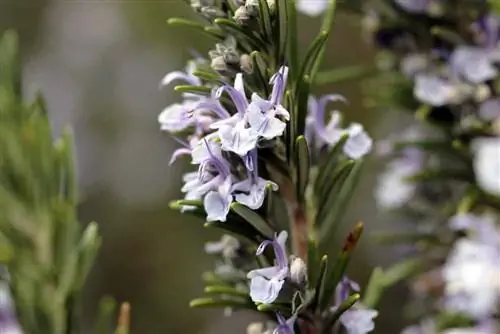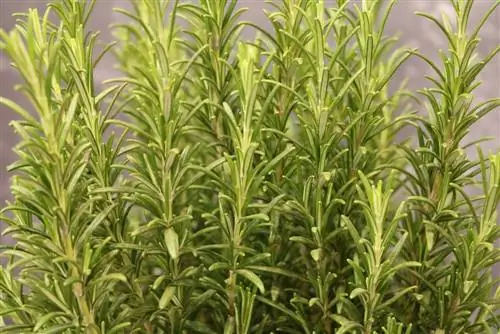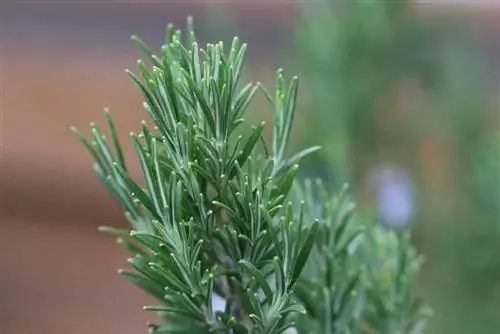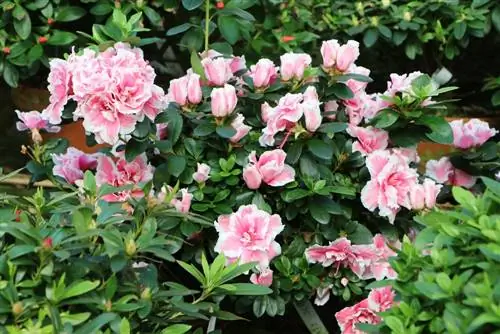- Author admin [email protected].
- Public 2023-12-17 03:39.
- Last modified 2025-06-01 06:48.
Aromatic, spicy and he althy - rosemary is now one of the most popular herbs in German gardens and is usually found in pots alongside thyme and basil. The needle-like leaves of the Mediterranean plant can then be harvested throughout the summer and added to various dishes to season them. However, when the days become shorter again, the hobby gardener should consider the question of winter storage. Especially if the plant is to be overwintered outdoors, appropriate measures must be taken to ensure that the rosemary bush survives the cold season unscathed.
Winter festival only in certain areas
Rosemary is a Mediterranean subshrub that is primarily native to southern European countries and the Mediterranean and prefers sunny, warm climates. In winter, the plant enjoys hot, dry summers and mild, rainy winter months in its homeland. Since these conditions do not exist in many areas of Germany and rosemary is only partially hardy, overwintering the plant outdoors can be difficult; The plant is considered winter-hardy or partially hardy because it is basically capable of overwintering, but requires suitable protection for this.
In addition, it is only possible in certain areas with mild winters to bring the Mediterranean subshrub outdoors through the cold season; Here the temperatures do not drop below minus 10°C. Wintering is therefore particularly successful in the northwestern lowlands, along the Lower Rhine and along the Rhine Graben. Trying to hibernate outdoors is particularly worthwhile here.
Choice of variety and age - this is how rosemary becomes winterproof
Whether the plants survive the winter unscathed does not only depend on the area in which they are grown; In addition, the choice of variety also plays an important role. Today there are more frost-resistant varieties on the market, which make safe wintering more likely. These include:
- Arp
- Salem
- Hill Hardy
- Veitshöchheim
- Sudbury Gem
- Madeleine's Hill
Tip:
If these varieties are preferred, the frost hardiness can be extended up to minus 20°C! However, the prerequisite is that these temperatures only prevail occasionally.
The age of the rosemary bush also plays a role when trying to overwinter the Mediterranean plant; The chance of successfully getting an old bush through the cold season is much higher than with a young plant; The older plants have a widely branched root system that has already grown deep into the soil. As a rule of thumb, rosemary plants under three years old should not be left outdoors during the cold season.
Preparing for the cold season
When planting rosemary, you should think about later overwintering - especially if this is to take place outdoors. The plant thrives particularly well in loose and stony soil and in a sunny spot; In this substrate it is well prepared for the cold season and can overwinter without any problems. It is a good idea to cultivate the plant in a pot so that it can be moved to a suitable outdoor location in winter.

However, it is particularly important to care for rosemary in a low-nutrient manner. If the Mediterranean subshrub is supplied with fertilizer during the summer, the leaves become more sensitive and are much less able to withstand low temperatures and periods of frost. It is also important to avoid pruning in the fall. Pruning the shrub means removing important foliar resources that the plant needs for successful overwintering.
Location on the terrace
The optimal location on the balcony or terrace guarantees that the plant is not damaged during the cold season. Particular attention should be paid to the fact that
- don't freeze the roots
- do not freeze the woody branches
- the ground is not completely frozen
- the roots don't rot
In order for these conditions to be met, it is important to protect the plant from icy winds. For this reason, a covered terrace is particularly suitable as a location. In addition, a small canopy on the balcony protects against moisture from rain or snow.
In addition, it has proven useful to move the herb pot close to the wall of the house - preferably the south wall.
Tip:
If severe frost periods are imminent, the rosemary can also be protected under a frame with a tarpaulin.
Protection for the planter
In addition to the correct location on the balcony, protecting the planter also plays an important role. To ensure that the Mediterranean subshrub survives the cold season as winter-proof as possible, it is a good idea to place the pot or bucket on a Styrofoam plate; In this way, hypothermia is prevented and the bottom of the pot does not freeze solid. In addition, the plant is optimally protected from moisture penetrating from below.
In addition to soil protection, it has proven useful to winterize the area around the planting hole. This works with the following methods:
- generous mulching around the planting hole
- Cover with brushwood
- Covering with a hood
For light winter protection, the soil is generously covered with old leaves, whereby the layer of leaves should be several centimeters. Particular attention must be paid to the high air permeability of this natural winter protection, which is why the leaves must not be trampled under any circumstances. To ensure that the winter protection is not carried away by rising winds, the leaf layer is additionally secured with a few twigs or pine green.
In large plants, the branches of the rosemary bush must also be protected; Not only is protection from the cold important, but also from strong sunlight. When the sun shines, large amounts of water often evaporate through the leaves. If the rosemary bush is protected and no liquid is supplied from outside, there is a risk that the plant will dry out. Additional frost increases the risk because water cannot be transported in frozen soil. On the other hand, the above-ground parts need protection from too much moisture, which can cause the sensitive root area to rot first and then die later.

In order to protect the above-ground parts of the plant, it has proven useful not only to pile up materials, but also to completely cover the plant. It is important to ensure that the material used is permeable to air. The following are particularly suitable:
- Jute covers
- Hoods made of plastic fleece
- Bamboo mats fixed to racks
- Coconut carpets
Care in winter
During the cold season, the rosemary bush requires little care. Conditionally hardy, the plant needs to be supplied with water at least now and then - especially in strong sunlight. Just enough water is used to prevent the bush from drying out. The water must drain optimally after irrigation so that no waterlogging occurs.
Particularly if the rosemary is covered with a hood, it must be ventilated regularly. The cover is therefore removed on frost-free days. At this opportunity the plant should be inspected for frost damage; However, pests are not to be expected when overwintering outdoors.
Above all, during the cold season there should be no additional supply of nutrients that make the plant more sensitive.
It should also be noted that the location once chosen for the rosemary bush must be maintained throughout the winter. Constantly switching between overwintering outdoors and staying indoors damages the plant. If you decide to keep the plant indoors for the winter after the plant has spent a few weeks on the balcony, you should stick to your decision. The herb begins to sprout again in the house; Moving outdoors again is no longer advisable - especially because the plant, spoiled by the warm temperatures, is no longer as hardy as it was before moving indoors.
End of wintering - remove winter protection and cut
The end of wintering is heralded when temperatures gradually rise again in spring. Then you can cut the bush back. First, however, the cover is removed from the plant - initially only for a few hours to harden the plant. The leftover leaves, mats and frames can also be removed.

If you want to cut back your rosemary now, you should make a generous cut - about 10 to 20 centimeters above the ground. The bush sprouts quickly again.
Conclusion
With the right care measures and safety precautions, overwintering rosemary is easy - even if the plant is only partially hardy. If the Mediterranean plant has successfully survived the winter, the hobby gardener can look forward to seeing the tasty herb grow again the following year.






